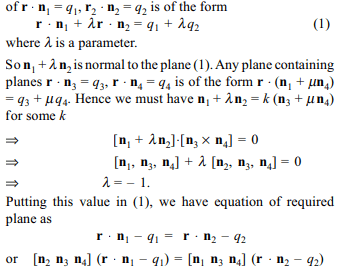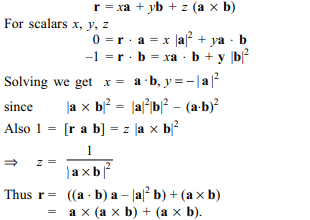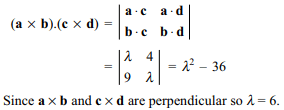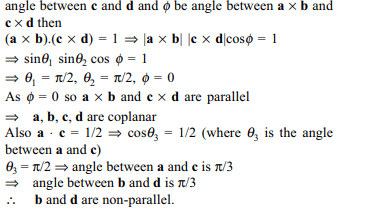1. Let \[a=3\lambda i+\left(2\lambda+1\right)j+\left(\lambda+1\right)k\]
\[b=\left(2\lambda-1\right)i+\left(2\lambda-1\right)j+\left(\lambda-2\right)k\]
\[c=\left(4\lambda-1\right)i+3\lambda j+2\lambda k\]
Product of all the values of \[\lambda\] is for which a, b, c are
coplanar is
a) 1
b) 0
c) -1
d) -2
Explanation: a, b, c are coplanar

2. A vector equation of the line of intersection
of the planes
\[r=b+\lambda_{1}\left(b-a\right)+\mu_{1}\left(a+c\right)\]
\[r=c+\lambda_{2}\left(b-c\right)+\mu_{1}\left(a+b\right)\]
a, b, c being non-coplanar vectors is.
a) \[r=a+\mu_{1}\left(b+c\right)\]
b) \[r=b+\mu_{1}\left(a+2c\right)\]
c) \[r=a+\mu_{1}\left(b+2c\right)\]
d) \[r=b+\mu_{1}\left(a+c\right)\]
Explanation: At points of intersection of the two planes, we have


3. An equation of a plane containing the
lines \[r=a_{1}+t b_{1}\] and \[r=a_{2}+t b_{2}\] where \[\left[a_{2}-a_{1},b_{1},b_{2}\right]\] = 0 is
a) \[\left[r-a_{1},b_{1},b_{2}\right]=0\]
b) \[\left[r-a_{2},b_{1},b_{2}\right]=0\]
c) \[\left[r-a_{2},a_{1},b_{2}\right]=0\]
d) \[\left[r-a,a_{2},b_{2}\right]=0\]
Explanation: The given lines passes through the points with

4. The equation of the plane which passes
through the line of intersection of the planes \[r.n_{1}=q_{1},r.n_{2}=q_{2}\] and is parallel to the line of intersection of the
line of intersection of the planes \[r.n_{3}=q_{2}\] and \[r.n_{4}=q_{4}\] given that \[\left[n_{1}n_{3}n_{4}\right]=\left\{n_{2}n_{3}n_{4}\right\}\] is
a) \[r.n_{2}-q_{2}=r.n_{3}-q_{3}\]
b) \[r.n_{1}-q_{1}=\left[n_{1}n_{2}n_{3}\right]\left(r.n_{2}-q_{2}\right)\]
c) \[r.n_{1}-q_{1}=r.n_{2}-q_{2}\]
d) \[r.n_{3}-q_{3}=r.n_{1}-q_{1}\]
Explanation: Equation of any plane through the intersection

5. If r . a = 0, r . b = –1 and [r a b] = 1, \[a.b\neq 0,\mid a\times b \mid=1\] the value of r in terms of a and b is
a) \[a\times \left(a\times b\right)+a\times b\]
b) \[a\times \left(a\times b\right)+\frac{a\times b}{\mid a\times b \mid^{2}}\]
c) \[a\times \left(b\times a\right)+\frac{b\times a}{\mid b\times a \mid^{2}}\]
d) \[\frac{ a\times \left(a\times b\right)}{\mid a\times \left(a\times b\right) \mid}+a\times b\]
Explanation: Writing r as linear combination of a, b and a \[\times\] b, we have

6. If \[a\times b\] and \[c\times d\] are perpendicular
satisfying \[a. c=\lambda\] , \[b.d=\lambda\] , ( \[\lambda\] > 0) a . d = 4, b . c = 9
then \[\lambda\] is equal to
a) 2
b) 3
c) 6
d) 36
Explanation:

7. Let a, b, c be unit vectors such that a + b
+ c = 0. Which one of the following is correct?
a) \[a\times b=b\times c=c\times a=0\]
b) \[a\times b=b\times c=c\times a\neq0\]
c) \[a\times b=b\times c=a\times c\neq0\]
d) \[a\times b,b\times c,c\times a\] are mutually perpendicular
Explanation: a + b + c = 0 \[\Rightarrow\] a, b, c are coplanar. Also no two of a, b, c can be parallel, for if a is parallel to b, then

8. Let two non-collinear unit vectors a and b
form an acute angle. A point P moves so that at any time t
the position vector OP (where O is the origin) is given by
a cos t + b sin t. When P is farthest from origin O, let M be
the length of OP and u be the unit vector along OP. Then
a) \[u=\frac{a+b}{\mid a+b \mid}\] and \[M=\left(1+a.b\right)^{1/2}\]
b) \[u=\frac{a-b}{\mid a-b \mid}\] and \[M=\left(1+a.b\right)^{1/2}\]
c) \[u=\frac{a+b}{\mid a+b \mid}\] and \[M=\left(1+2a.b\right)^{1/2}\]
d) \[u=\frac{a-b}{\mid a-b \mid}\] and \[M=\left(1+2a.b\right)^{1/2}\]
Explanation: OP = a cos t + b sin t so

9. The edges of a parallelopiped are of unit
length and are parallel to non-coplanar unit vectors a, b, c
such that a . b = a . c = b . c = 1/2. Then the volume of the
parallelopiped is
a) \[1/\sqrt{2}\]
b) \[1/2\sqrt{2}\]
c) \[\sqrt{3}/2\]
d) \[1/\sqrt{3}\]
Explanation: (Volume)2 = [abc] [abc]


10. If a, b, c, d are unit vectors such that
\[\left(a\times b\right).\left(c\times d\right)=1\] and a . c = 1/2 then
a) a, b, c are non-coplanar
b) b, c, d are non-coplanar
c) b, d are non-parallel
d) a, d are parallel and b, c are parallel
Explanation: Let \[\theta_{1}\] be the angle between a and b, \[\theta_{2}\] be the
